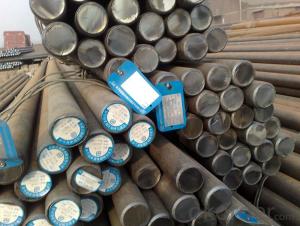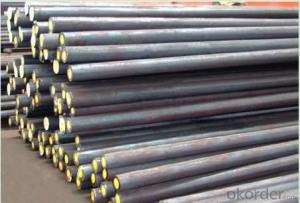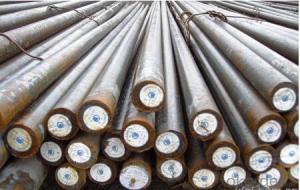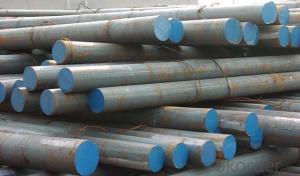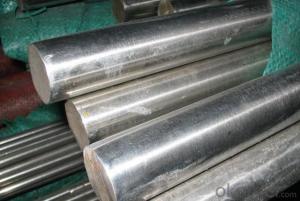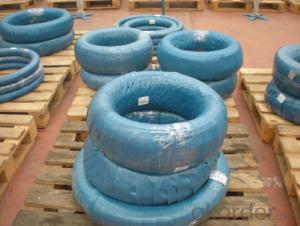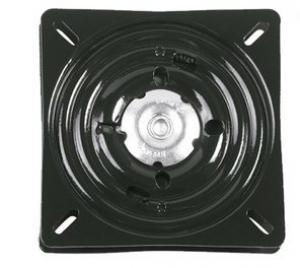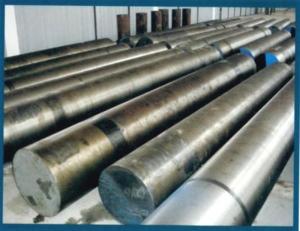Alloy Steel 100cr6/52100/GCr15/SUJ2 Bearing Steel
- Loading Port:
- China main port
- Payment Terms:
- TT OR LC
- Min Order Qty:
- 25 m.t.
- Supply Capability:
- 10000 m.t./month
OKorder Service Pledge
OKorder Financial Service
You Might Also Like
Item specifice
The details of our Steel
1. Produce Standard: as the GB, AISI, ASTM, SAE, EN, BS, DIN, JIS Industry Standard
2. Produce processes: Smelt Iron -EAF smelt Billet - ESR smelt Billet -Hot rolled or forged get the steel round bar and plate
3. Heat treatment:
Normalized / Annealed / Quenched+Tempered
4. Quality assurance:
All order we can received Third party inspection, You can let SGS, BV,.. and others test company test and inspect our products before Goods shipping.
Product information
Chemical Composition(GB)%
C | Si | Mn | Cr | Cu | S |
0.95-1.05 | 0.15-0.35 | 0.25-0.45 | 1.4-1.65 | ≤0.20 | ≤0.020 |
Heat Treatment
Item | Temperature ℃ | Hardness |
Anneal | 790-810 | 170-207HB |
Quenching | 830-860 | 62-66HRC |
Tempering | 150-180 | 61-66HRC |
Characterstics
1.Uniform hardness,Good abrasion resistance |
2.High contact fatigue resistance |
3.Cutting performance in general |
Applications: Used to make the load of the larger small cross-section conditioning and stress smaller large parts
Product show

Workshop show
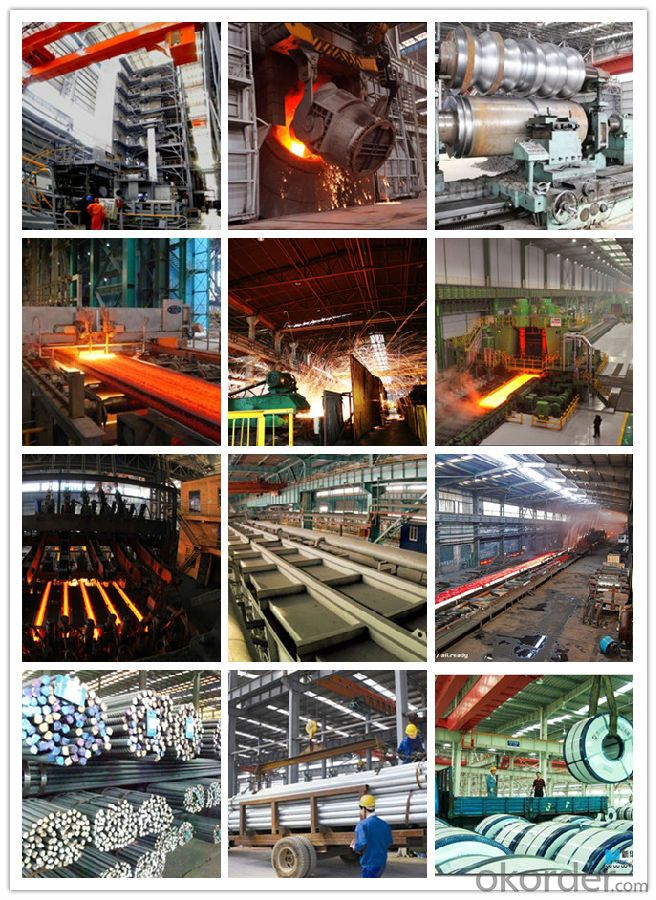
- Q:What are the properties of high-strength stainless steel?
- High-strength stainless steel possesses several key properties such as excellent corrosion resistance, high tensile strength, good ductility, and resistance to extreme temperatures. This type of steel also offers exceptional durability, making it suitable for various demanding applications in industries such as automotive, aerospace, and construction.
- Q:What are the challenges in machining special steel with complex geometries?
- Machining special steel with complex geometries poses several challenges. Firstly, the hardness and toughness of special steel can make it difficult to cut, requiring specialized tools and techniques. Additionally, the intricate geometries of the components can pose challenges in terms of accessing and maneuvering the cutting tools, which may require specialized equipment or processes. Furthermore, the heat generated during machining can affect the properties of special steel, such as its hardness and dimensional stability, requiring careful monitoring and control. Overall, machining special steel with complex geometries demands expertise, precision, and adaptability to overcome these challenges.
- Q:What are the advancements and trends in the field of special steel?
- In recent years, there have been significant advancements and emerging trends in the field of special steel. One major advancement is the development of high-strength and high-performance alloys, which offer improved mechanical properties and resistance to wear, corrosion, and extreme temperatures. Additionally, there has been a focus on the production of special steel with enhanced sustainability and reduced carbon footprint, in response to growing environmental concerns. Another trend is the increasing use of special steel in additive manufacturing or 3D printing, allowing for the creation of complex and customized components. Furthermore, the integration of digital technologies and automation in steel production processes has improved efficiency, quality control, and overall productivity. These advancements and trends in special steel continue to drive innovation and expand its applications across various industries, such as automotive, aerospace, energy, and construction.
- Q:How does special steel resist fatigue?
- The durability and strength of special steel are enhanced through the incorporation of specific properties that resist fatigue. The high tensile strength of this steel is a primary factor in its ability to withstand stress and load without deforming or breaking, preventing the initiation and spread of fatigue cracks. In addition, special steel often undergoes heat treatment processes like quenching and tempering to further enhance its fatigue resistance. This alters the steel's microstructure, creating a fine and uniform grain structure that improves its mechanical properties. It increases hardness and toughness, reducing susceptibility to fatigue failure. Furthermore, special steel can be alloyed with elements like chromium, molybdenum, and vanadium to enhance its resistance to fatigue. These elements form carbides and other strengthening phases within the steel, improving hardness, strength, and resistance to fatigue crack propagation. Moreover, specialized surface treatments like shot peening and nitriding can be applied to special steel. Shot peening involves bombarding the steel surface with small metal particles, inducing compressive residual stresses. These stresses counteract the tensile stresses that cause fatigue cracks, thus enhancing fatigue resistance. Nitriding involves diffusing nitrogen into the steel surface, creating a hardened layer that improves wear resistance and, consequently, fatigue resistance. In conclusion, special steel resists fatigue through a combination of factors, including high tensile strength, specific heat treatment processes, alloying elements, and specialized surface treatments. These properties work together to enhance the steel's durability, strength, and resistance to fatigue crack initiation and propagation, making it a reliable and long-lasting material for various applications.
- Q:How does special steel contribute to the aerospace defense machinery industry?
- Special steel plays a crucial role in the aerospace defense machinery industry by providing exceptional strength, durability, and resistance to corrosion and high temperatures. It is used extensively in the manufacturing of various components such as landing gears, turbine blades, structural frames, and armor plating for military aircraft and defense systems. Its unique properties ensure optimal performance, safety, and reliability of these critical machines, enabling them to withstand challenging environments and extreme operating conditions.
- Q:Can special steel be used in the manufacturing of tools?
- Yes, special steel can be used in the manufacturing of tools. Special steels, such as high-speed steel, tool steel, and alloy steel, are specifically designed to have exceptional strength, hardness, and durability properties. These characteristics make special steel ideal for tool manufacturing, as it can withstand high temperatures, resist wear and corrosion, and provide the necessary toughness required for various cutting, shaping, and drilling applications.
- Q:What are the different surface finishing methods used for special steel?
- There are several surface finishing methods used for special steel, each serving a specific purpose and achieving different results. Some of the common surface finishing methods for special steel include: 1. Grinding: Grinding is the process of using abrasive materials to remove excess material from the surface of the steel. It is typically used to achieve a smooth and polished finish, as well as to remove any imperfections or roughness. 2. Polishing: Polishing involves using polishing compounds and abrasive materials to create a smooth and shiny surface on the steel. This method is often used to enhance the aesthetic appeal of the steel and improve its corrosion resistance. 3. Shot blasting: Shot blasting is a technique that involves propelling small metal or mineral particles at high speeds onto the surface of the steel. This process helps to remove any contaminants, scale, or rust from the surface, resulting in a clean and uniform finish. 4. Electroplating: Electroplating is a process where a thin layer of metal is deposited onto the surface of the steel through an electrochemical reaction. This method is commonly used to enhance the appearance of the steel, improve its corrosion resistance, and provide a decorative or protective coating. 5. Passivation: Passivation is a chemical process that involves treating the surface of the steel with an acid solution to remove any impurities and create a passive, corrosion-resistant layer. This method is often used to improve the corrosion resistance of stainless steel and other alloys. 6. Coating: Coating is the process of applying a protective layer or coating onto the surface of the steel. This can include paints, lacquers, enamels, or other types of protective coatings that help to prevent corrosion, improve durability, or provide a specific aesthetic finish. It is important to note that the choice of surface finishing method for special steel depends on the desired outcome, such as aesthetics, corrosion resistance, or functionality. Additionally, the specific characteristics of the steel, such as its composition, hardness, and intended application, also play a significant role in determining the most suitable surface finishing method.
- Q:What are the different methods of surface hardening for special steel?
- Special steel can be surface hardened using various methods. These methods comprise: 1. Carburizing: By subjecting the steel to a carbon-rich environment, such as gas or liquid, carbon atoms can infiltrate the steel surface. This results in enhanced surface hardness and wear resistance. 2. Nitriding: Steel is heated in an environment rich in nitrogen, causing nitrogen atoms to permeate the surface. This creates a durable, wear-resistant outer layer. 3. Induction hardening: By passing an alternating current through a coil, a magnetic field is generated, inducing electrical currents in the steel. The resistance to these currents generates heat, leading to high surface temperatures and rapid quenching, ultimately increasing hardness. 4. Flame hardening: The steel surface is heated using a flame or oxy-fuel torch, followed by quenching in water or oil. The swift cooling from elevated temperatures facilitates surface hardening. 5. Laser hardening: Laser beams are employed to rapidly heat a specific area of the steel surface, which is then promptly cooled with a coolant. This localized heating and cooling process enhances the hardness of the treated region. 6. Plasma nitriding: Steel is placed in a low-pressure plasma chamber, where nitrogen ions bombard the surface, facilitating nitrogen diffusion and the formation of a hardened layer. Each method offers distinct advantages and is suitable for diverse applications and types of special steel. The selection of a surface hardening method depends on factors such as desired hardness, dimensional limitations, and specific application requirements.
- Q:What are the applications of special steel in the agriculture supply chain?
- Special steel has several applications in the agriculture supply chain. It is commonly used in the manufacturing of farm equipment and machinery such as tractors, plows, and harvesters. Special steel's high strength and durability make it ideal for these heavy-duty applications, ensuring that the equipment can withstand the demanding conditions of the agricultural sector. Additionally, special steel is also used in the production of storage tanks and silos, providing a robust and reliable solution for storing grains, fertilizers, and other agricultural products.
- Q:How does special steel enhance the performance of cutting tools?
- Special steel enhances the performance of cutting tools in several ways. Firstly, special steel is designed to have a higher hardness and wear resistance compared to standard steel. This increased hardness allows cutting tools to maintain their sharpness for a longer period, resulting in improved cutting efficiency and accuracy. Additionally, the high wear resistance of special steel ensures that the cutting edges of the tools do not wear down quickly, enabling them to withstand the high forces and pressures involved in cutting operations. Furthermore, special steel often has superior toughness and strength compared to regular steel. This enhanced toughness allows cutting tools to withstand impacts and vibrations without breaking or chipping, ensuring their durability and longevity. The increased strength of special steel also enables cutting tools to handle higher cutting speeds and feed rates, thereby improving productivity and reducing machining time. Special steel also offers excellent heat resistance properties, which is crucial for cutting tools that are subjected to high temperatures during machining processes. This heat resistance prevents the cutting edges from becoming soft or deforming, which can result in poor cutting performance and reduced tool life. Additionally, special steels can have improved corrosion resistance, preventing the tools from rusting or corroding when exposed to moisture or aggressive cutting fluids. In summary, the unique properties of special steel, including higher hardness, wear resistance, toughness, strength, heat resistance, and corrosion resistance, all contribute to enhancing the performance of cutting tools. These characteristics enable cutting tools to maintain their sharpness, withstand high forces and temperatures, resist wear and corrosion, and ultimately, improve cutting efficiency, accuracy, and tool life.
1. Manufacturer Overview |
|
|---|---|
| Location | |
| Year Established | |
| Annual Output Value | |
| Main Markets | |
| Company Certifications | |
2. Manufacturer Certificates |
|
|---|---|
| a) Certification Name | |
| Range | |
| Reference | |
| Validity Period | |
3. Manufacturer Capability |
|
|---|---|
| a)Trade Capacity | |
| Nearest Port | |
| Export Percentage | |
| No.of Employees in Trade Department | |
| Language Spoken: | |
| b)Factory Information | |
| Factory Size: | |
| No. of Production Lines | |
| Contract Manufacturing | |
| Product Price Range | |
Send your message to us
Alloy Steel 100cr6/52100/GCr15/SUJ2 Bearing Steel
- Loading Port:
- China main port
- Payment Terms:
- TT OR LC
- Min Order Qty:
- 25 m.t.
- Supply Capability:
- 10000 m.t./month
OKorder Service Pledge
OKorder Financial Service
Similar products
New products
Hot products
Hot Searches
Related keywords

